Morocco is a country full of contrasts: hustle and bustle in the old towns, tranquility and endless expanse in the desert, winding mountain roads, and chattering seagulls on the Atlantic. If you want to experience as much as possible, a 10-day Morocco tour is simply perfect for getting to know the country.
From the bustling Medina in Marrakech, to ancient kasbahs and deep gorges in the Atlas Mountains, to the sand dunes of the Sahara, you’ll get a really good impression in a short time. And if you want to relax by the sea for a few days at the end, that’s easily doable too.
In this article, we’ll show you a great route through Morocco that worked really well for us. Perfect if you’re visiting Morocco for the first time and are looking for a good mix of culture, nature, and a road trip. We’ll also include our best planning tips and all the highlights along the way. Enjoy browsing!
- Who is this Morocco tour suitable for?
- Morocco tour – itinerary & duration
- Morocco tour – sights & Highlights
- Day 1: Arrival in Marrakech
- Day 2: Exploring Marrakech
- Day 3: Drive over the Atlas Mountains to Aït Ben Haddou
- Day 4: The Kasbah Road
- Day 5: Todra Gorge and Merzouga
- Day 6: Palm oases in the Drâa Valley
- Day 7: Drive to Taghazout
- Day 8: Exploring Taghazout
- Day 9: The port city of Essaouira
- Day 10: Return to Marrakech & departure
- General Morocco travel tips
- Arrival: Which airports are suitable?
- Entry: Visa, passport & Import regulations
- Is renting a car worthwhile in Morocco?
- When is the best time for a Morocco tour?
- Safety: How safe is Morocco?
- How much does a Morocco tour cost?
- Internet in Morocco
- Morocco packing list: What should I definitely bring?
Who is this Morocco tour suitable for?
Our 10-day Morocco itinerary is simply ideal for anyone traveling to Morocco for the first time. In a short time, you’ll get a really good impression of what the country is all about: lively cities, impressive mountain landscapes, endless desert, small villages, and finally, the sea.
Starting in Marrakech is immediately colorful, loud, intense, but also totally fascinating. Then we cross the Tizi n’Tichka Pass into the Atlas Mountains and continue towards the Sahara Desert. Here you’ll experience exactly the Morocco that many people have in mind: palm oases, sunsets in the desert, Berber villages, mud castles, and a truly beautiful route through dramatic landscapes. And if you want to relax a bit at the end, you can simply drive to Essaouira or Taghazout, eat fish, enjoy the sun, and let the last few days come to a relaxing end. Morocco definitely has many sights that you can admire along the way.
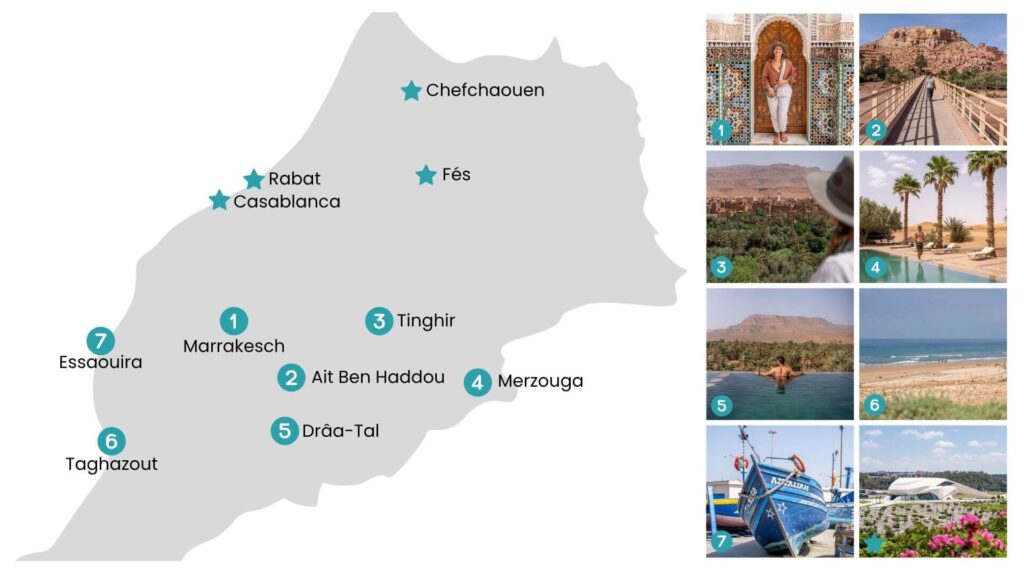
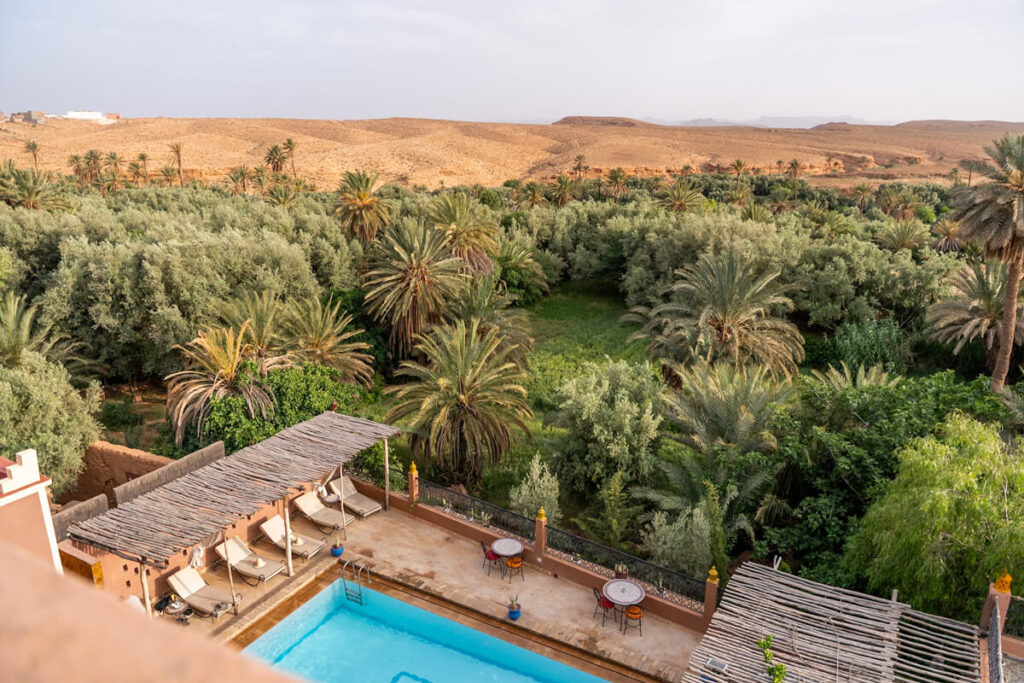


Morocco Tour – Itinerary & Duration
For a tour of Morocco, you should plan at least 7 days, but 10 to 14 days are better. Anything less quickly becomes stressful, especially if you also want to see the desert.
With 10 days, you have enough time to take in many highlights without rushing through it all. During this 10-day trip, you’ll get a really good impression of the country, but you’ll still have time to take a breather and even make it to the seaside at the end.
We did this “classic route” eight years ago, but we only had 14 days back then. If you have more time, it’s worth planning a bit more time, especially in Marrakech, the desert, and by the sea.
‼️ Important note: You’ll be covering quite a few kilometers, but if you enjoy being on the move and road trips, this is a good fit.
10-day road trip through Morocco
Overnight stops:
- Marrakech (2 nights)
- Ait Ben Haddou (1 night)
- Tinghir (1 night)
- Merzouga (1 night)
- Agdz (1 night)
- Taghazout (2 nights)
- Essaouira (1 night)
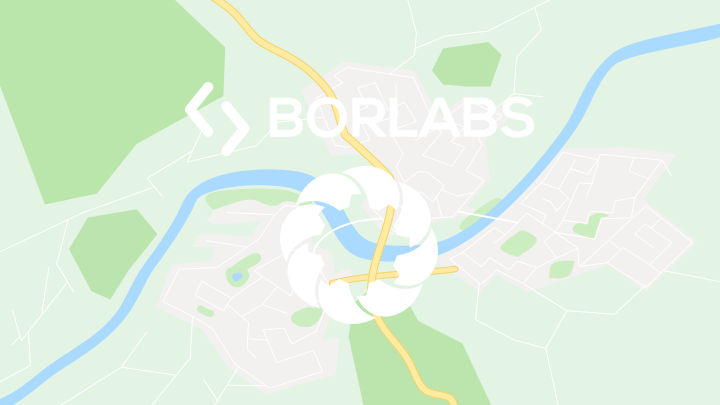
By loading the map, you accept Google’s privacy policy.
Find out more
Load map
Round trip Morocco – sights & Highlights
Day 1: Arrival in Marrakech
The adventure begins immediately upon your arrival in Marrakech. It’s best to book a beautiful riad in the heart of the medina. The small courtyards, roof terraces, and colorful mosaics make a striking impression, and you immediately feel like you’re in the center of the action.
Especially if this is your first time in Morocco, we recommend a guided tour of the medina* to get you started. This will give you a feel for the alleys, introduce you to the most important spots, and save you the initial shock of disorientation. Afterward, we believe you can let yourself drift much more relaxed.
Let the day end comfortably and don’t overplan. How about a first stroll through the souks? Or a cup of fresh mint tea on the roof terrace? Maybe you’ll even try your first street food at the famous Djemaa el Fna. No matter what you choose – welcome to Morocco.
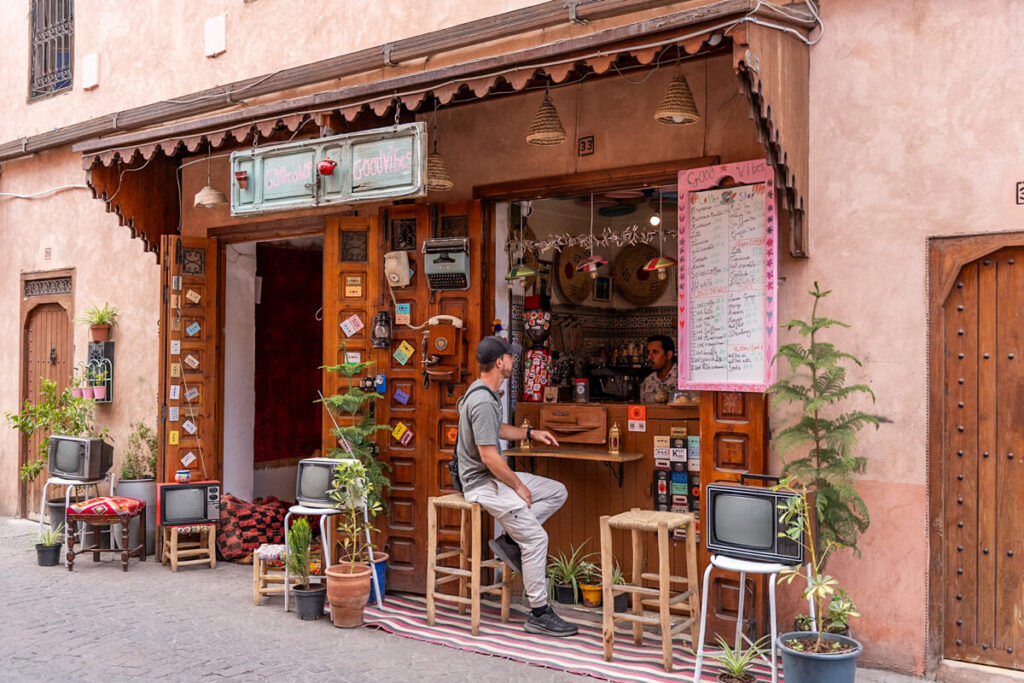


Day 2: Exploring Marrakech
Today you have a whole day to explore Marrakech. And you should definitely include a few highlights. If you started yesterday with a guided tour, you probably already have a good overview. Now you can explore the places that really interest you at your leisure.
Recommended for the morning: a visit to the Ben Youssef Koran School, the Bahia Palace, or the Saadian Tombs – depending on what you feel like. Also recommended are the Museum El Bacha and the Moroccan Culinary Arts Museum.
The Jardin Majorelle, with its bright blue flowers and cacti, is often busy, but if you book tickets in advance* (and go as late as possible), it’s totally worth it. An alternative is the Secret Garden. It’s much quieter and truly beautiful there, especially in the late afternoon.
In the afternoon, you can relax and stroll through the souks, shop for souvenirs, or just go with the flow. Marrakech may seem chaotic at first, but by now you’ll have settled into the rhythm. To round off your day, we recommend either a cooking class with a market visit* or a dinner on a rooftop terrace (e.g. in the La Pergola Restaurant).
More tips for your day in Marrakech:
- Marrakech: Balloon ride, Berber breakfast & certificate*
- Bahia Palace, Saadian Tombs, Souk and Medina tour*
- 3 hours of traditional Hammam & massage & Hotel transfer*
- Street food tour with a local guide*
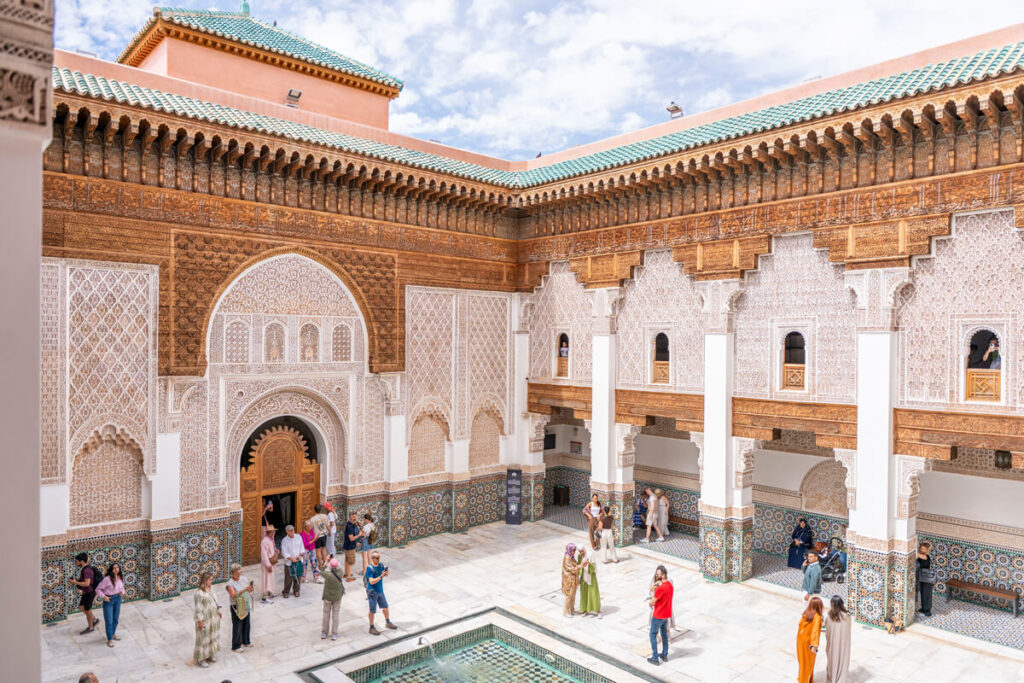
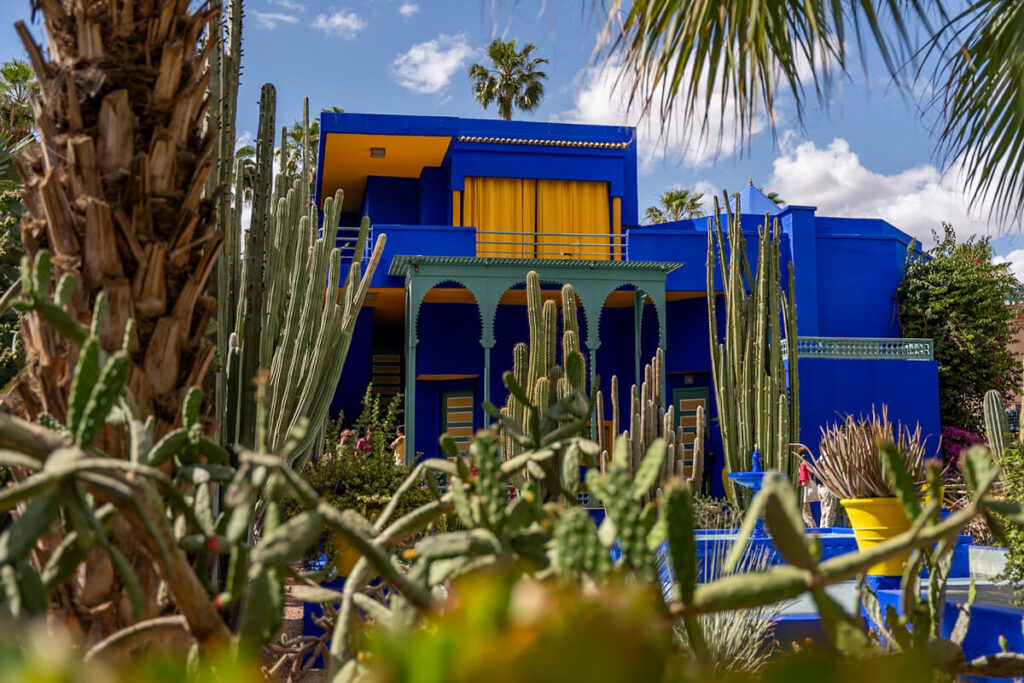
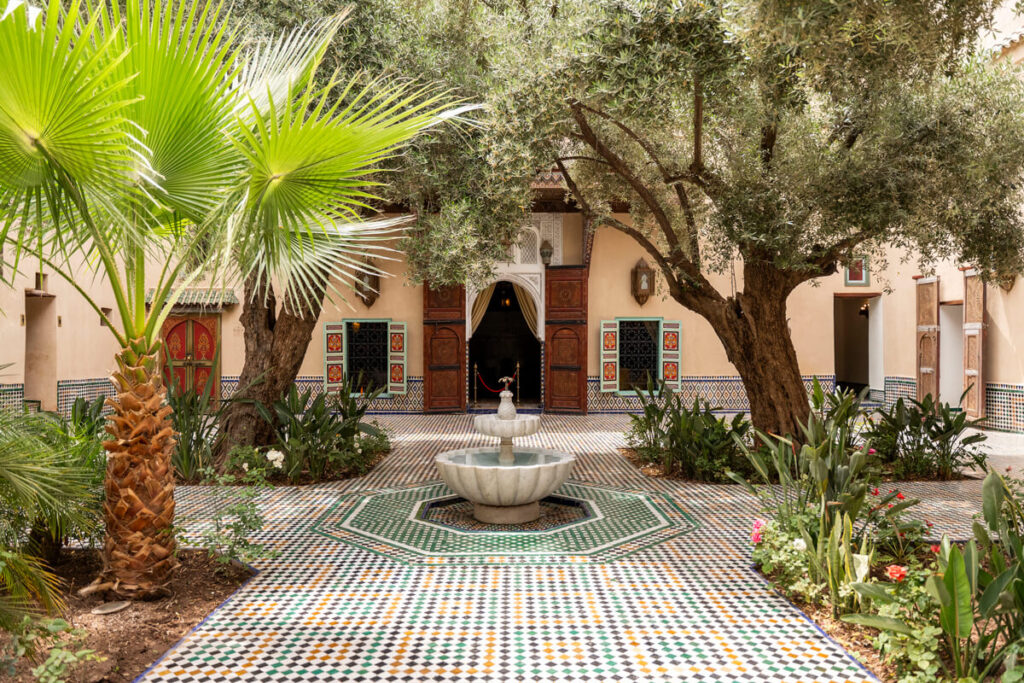
Day 3: Drive over the Atlas Mountains to Aït Ben Haddou
Today you leave the city and drive into the mountains. The route from Marrakech to Aït Ben Haddou takes you over the legendary Tizi n Tichka Pass. A winding but scenic route through the High Atlas Mountains.
Expect a drive of around four to five hours, depending on how often you stop. And you’ll want to, believe us! You’ll reach Aït Ben Haddou in the late afternoon. The mud city is a UNESCO World Heritage Site and one of Morocco’s most famous photo spots. It was used for filming for shows like Game of Thrones and Gladiator. If you still have energy, the climb to the top is worth it. The view of the village and the surrounding area is really good.
Our tips for Aït Ben Haddou:
- Parking costs 10 dirhams
- Entry into the clay village itself is free
- Tawesna Salon de thé (sweet teahouse)
- Tanmirt (good local restaurant)
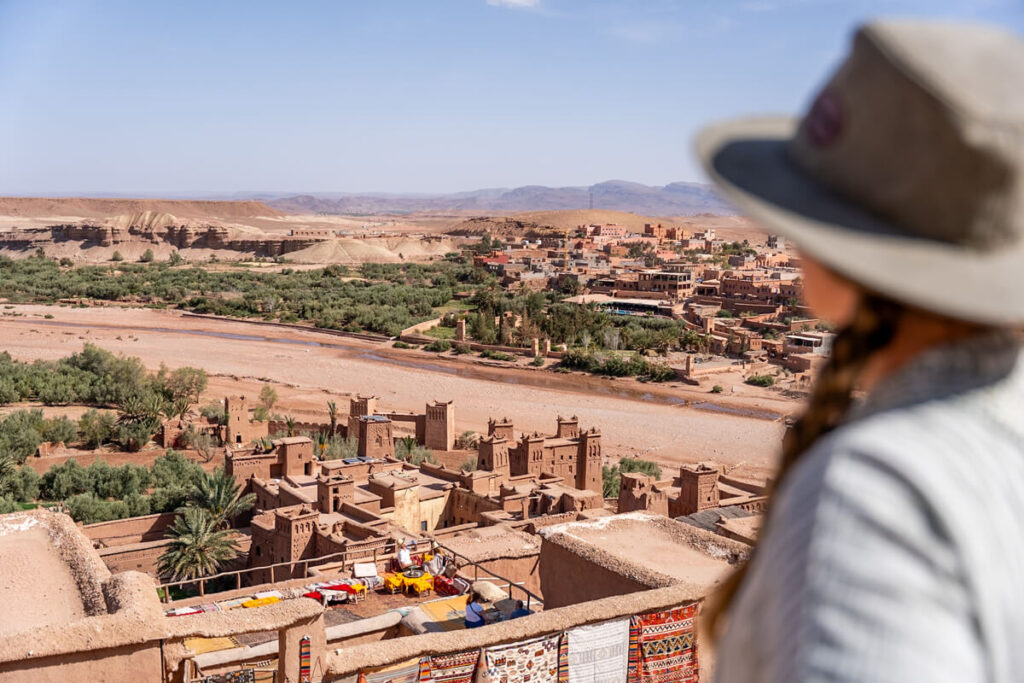
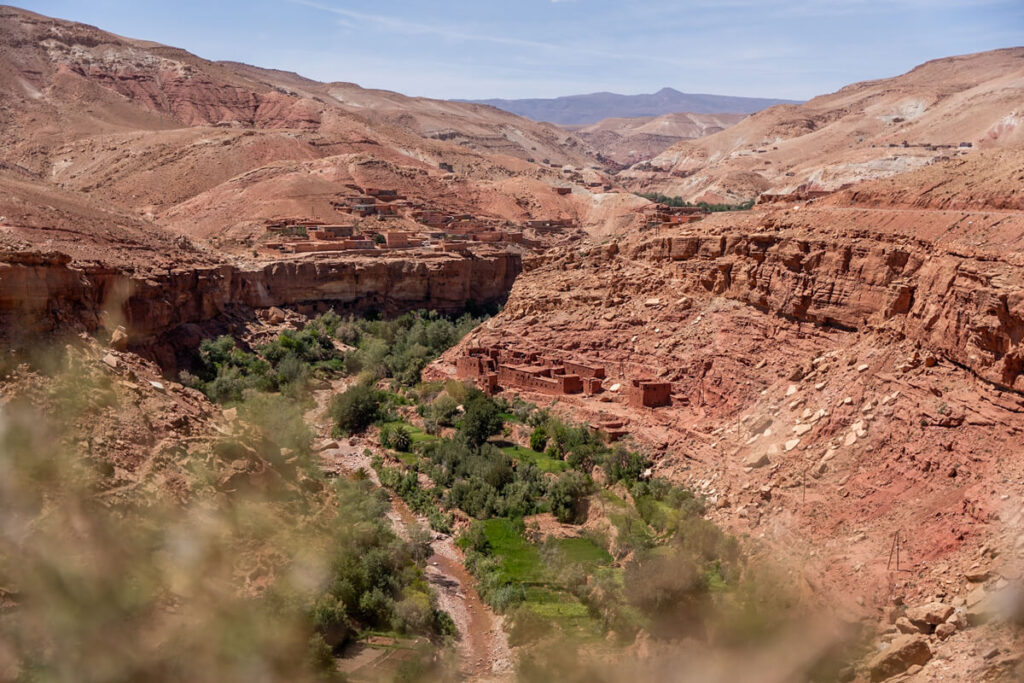
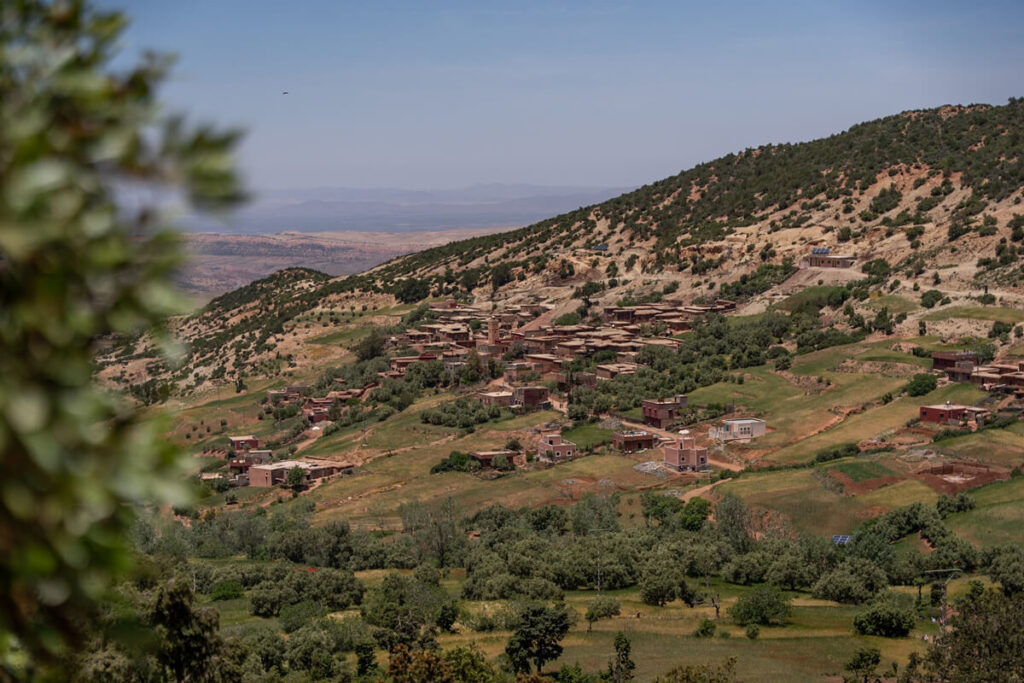
Day 4: The Kasbah Road
Today, another beautiful route awaits you: the famous Kasbah Road. From Ait Ben Haddou, you continue east – past mud castles, palm oases, and small villages. The landscape constantly changes between barren and green, and there are some beautiful spots for photography along the way.
A worthwhile stop is the Kasbah Amridil near Skoura. It is one of the best-preserved kasbahs in Morocco. You then continue through the fertile Dades Valley, where the road winds spectacularly through the mountains. If you feel like it, take a short detour to the famous serpentine road. The climb towards the Dades Gorge is worthwhile.
Your destination today is Tinghir. A quiet place on the edge of the desert and an ideal starting point for the Todra Gorge. The area is known for its palm groves and impressive mountain scenery. Perfect for a short evening stroll.

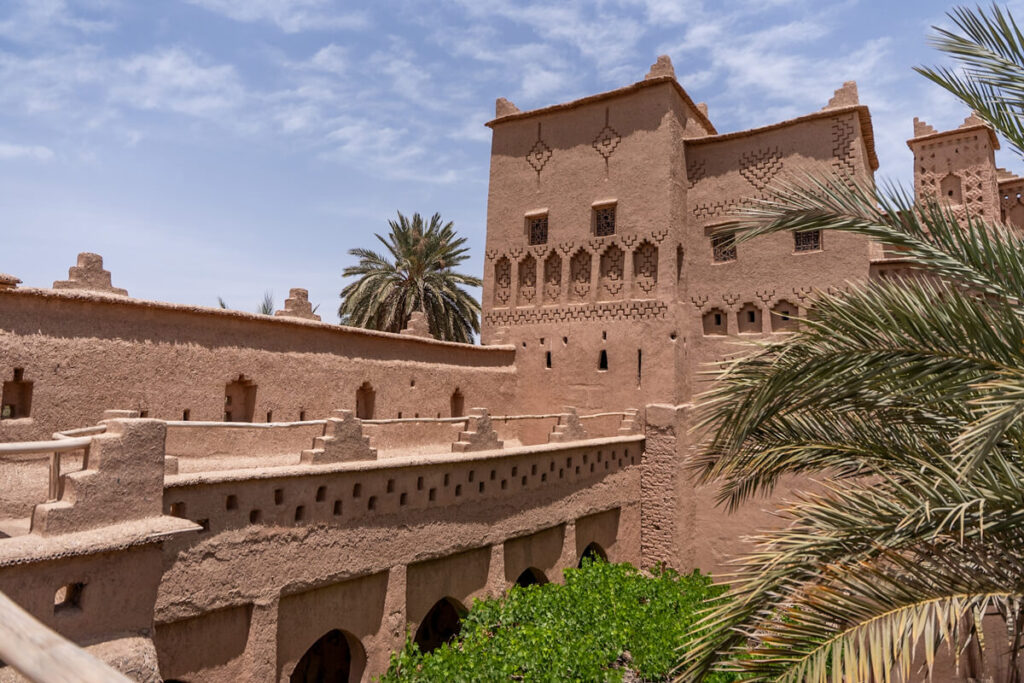

Day 5: Todra Gorge and Merzouga
In the morning, an early trip to the Todra Gorge is worthwhile. It’s best to get there before the tour buses arrive. The up to 300-meter-high rock walls are quite impressive, especially when the sun slowly sets between the rocks. You can walk part of the way into it or simply drive through it and make a few photo stops.
Afterward, you’ll continue towards the Sahara. The route is long, but you’ll pass through exciting places like Tinjdad and Erfoud. The landscape becomes increasingly dry, and eventually, the first sand dunes of Erg Chebbi appear. A truly special moment on this tour through Morocco.
Depending on your arrival time, you can first relax in the hotel or start your desert adventure directly. Many tours to the camp begin in the late afternoon (on foot, by camel, or by jeep). You definitely shouldn’t miss the sunset in the dunes. We had a beautiful hotel by the dunes* and were very happy with it!
Popular camps in Merzouga:
- Merzouga Luxury Camp*
- Tiziri Camp*
- Sahara Desert Luxury Camp*
- Best Desert Luxury Camp*
- Sky View Camp*
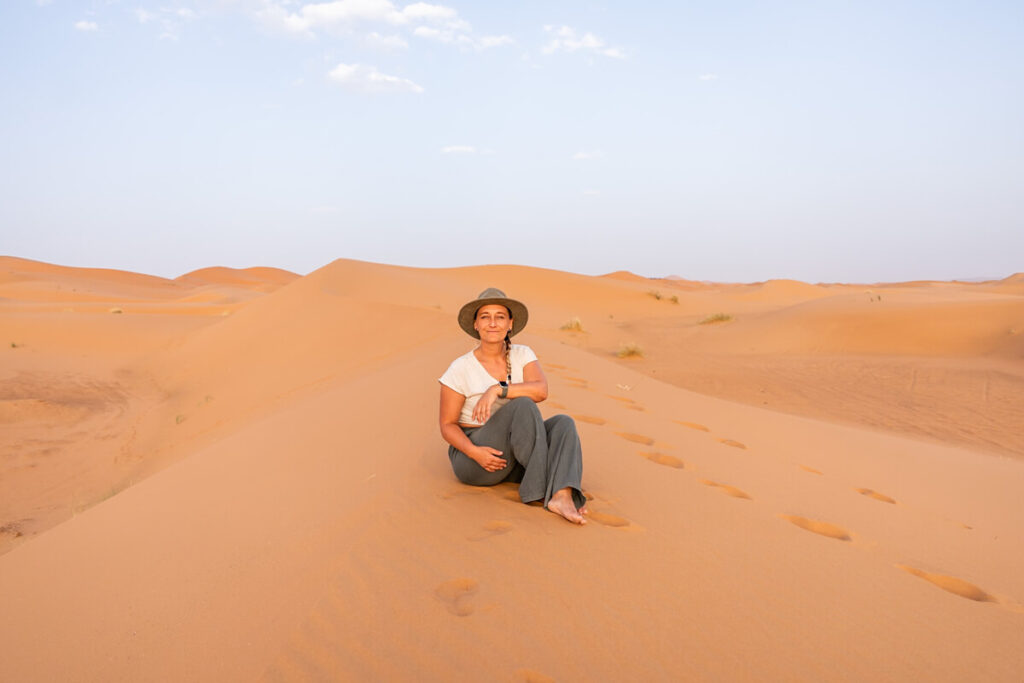
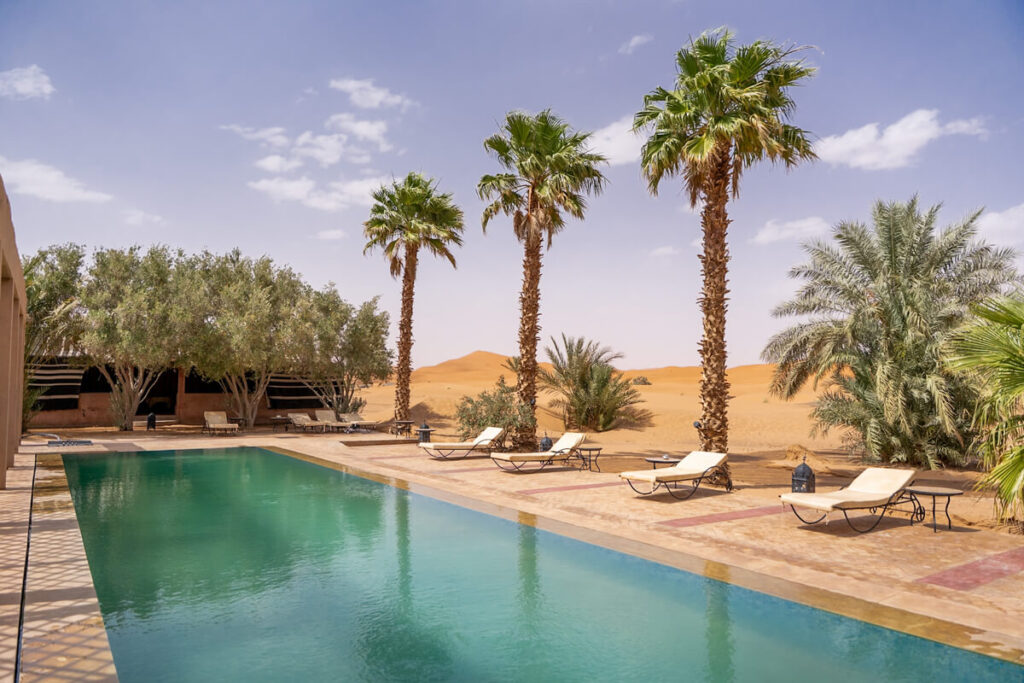
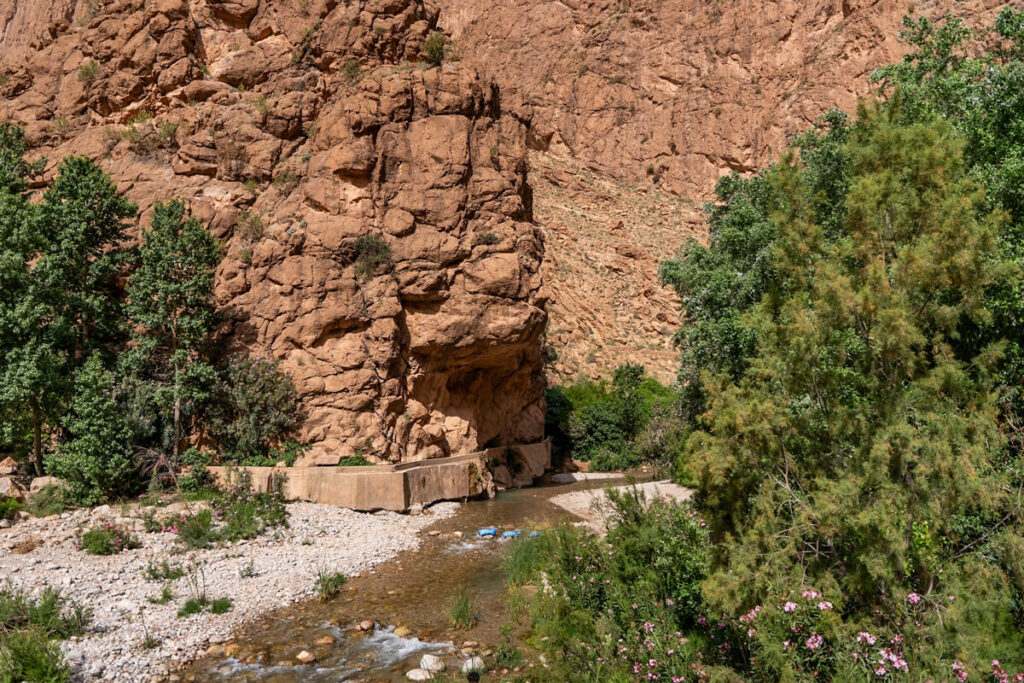
Day 6: Palm Oases in the Drâa Valley
After a night in the desert camp or hotel, you’ll continue west today. Out of the dunes and into the green Drâa Valley. The route is long, but the scenery is truly beautiful. Mud houses, palm groves, dry river valleys, and small villages alternate.
Your destination is the Kasbah Hnini near Taliouine*. The location is simply breathtaking. The restored mud fortress towers over a sprawling palm oasis with views of mountains, palm trees, and vast expanses. We spent the afternoon relaxing by the pool and simply taking a deep breath.
In the evening, there was a fantastic dinner on the terrace. Quiet, warm, good food, and that view. Simply amazing. And let’s be honest, who can say they’ve stayed in a real kasbah?

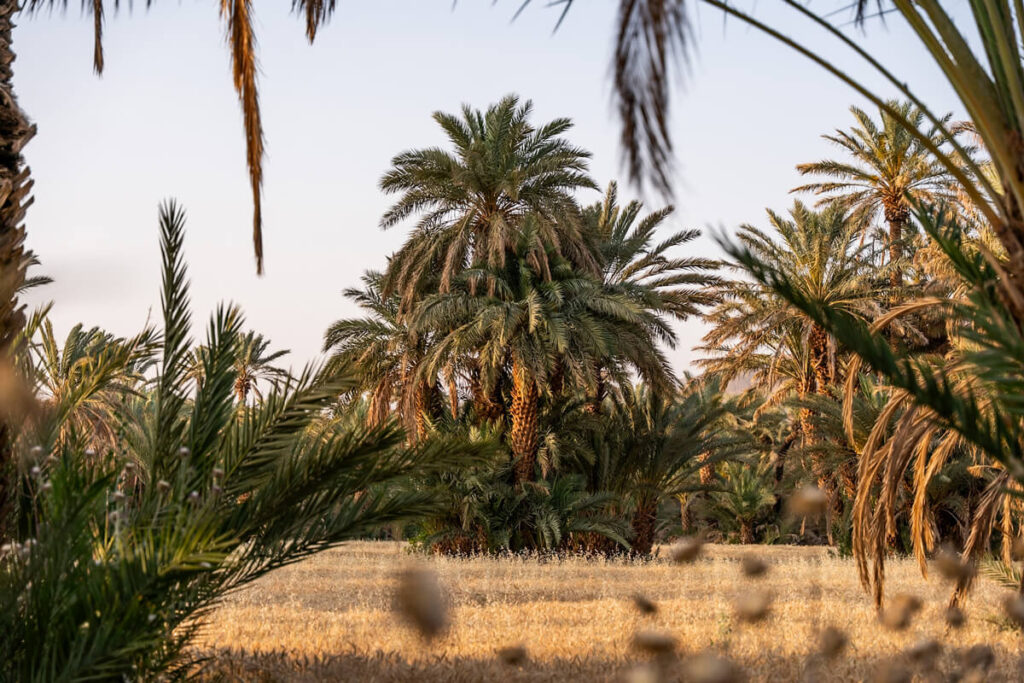
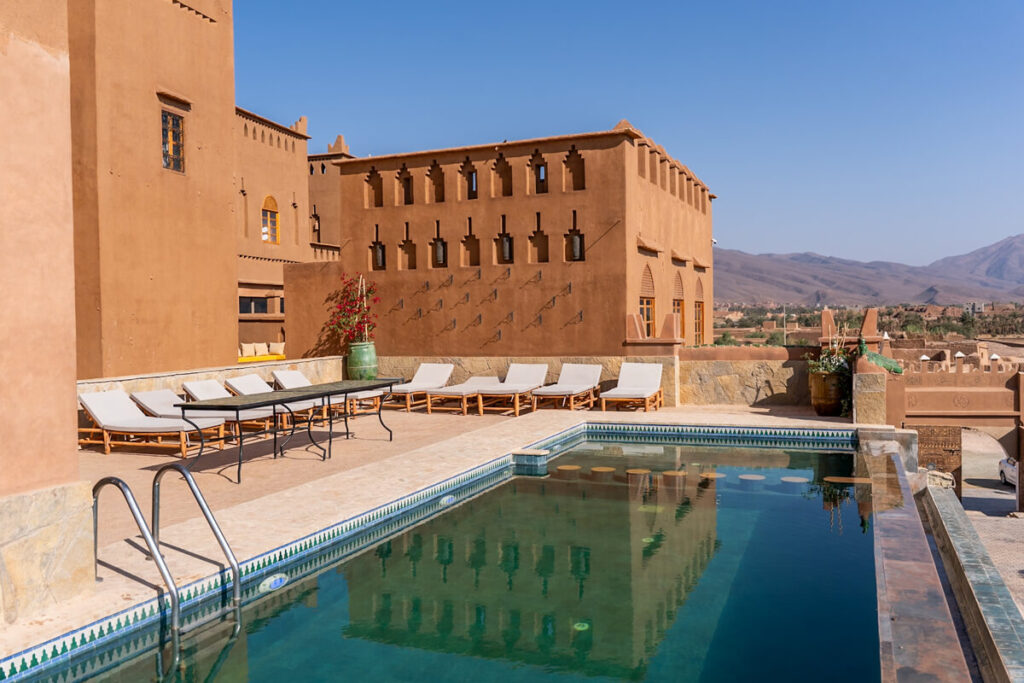
Day 7: Drive to Taghazout
On the 7th day of your Morocco tour, you’ll head to the Atlantic. The route is quite long at just under 6 hours, but varied. You’ll drive through the foothills of the Atlas Mountains, across plateaus, past small villages and wide valleys. If you set off early, you can already have your feet on the Atlantic by late afternoon.
Taghazout is a small town north of Agadir, known for surfing, relaxed vibes, and beautiful sunsets on the beach. Here you can really breathe deeply after the many impressions of the last few days. It’s best to look for accommodation with a roof terrace or sea view and simply treat yourself to a quiet evening by the sea.

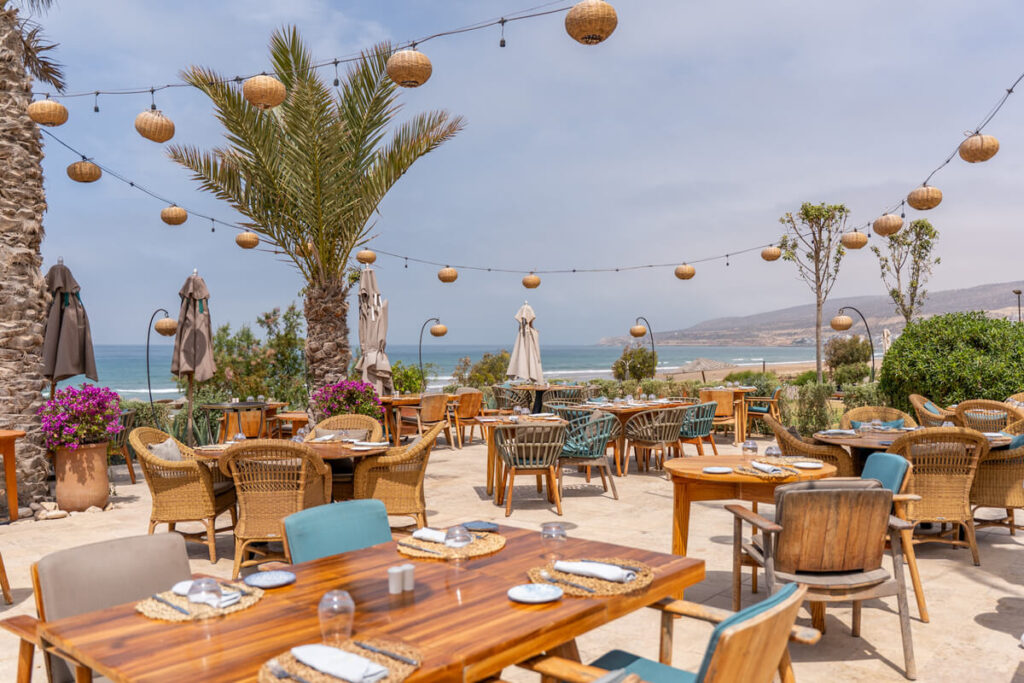
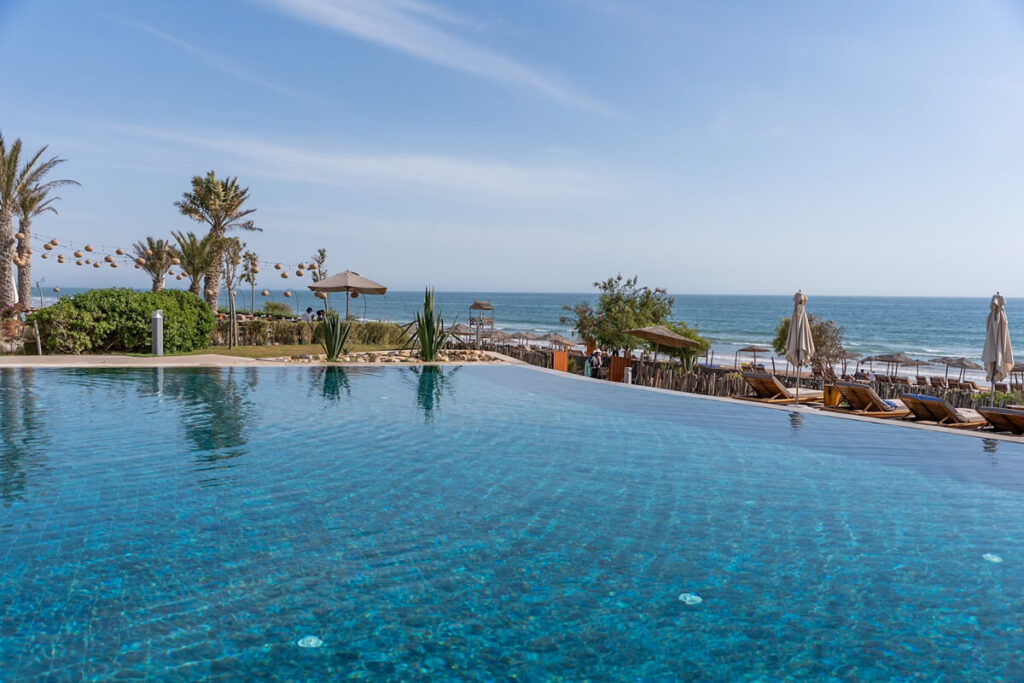
Day 8: Explore Taghazout
Today you can spend the whole day relaxing in Taghazout. In Taghazout you can try surfing* (also You can stroll through the village (even if you’re a complete beginner) with your board under your arm, or simply lie on the beach and do nothing. The surfer village is home to many cool cafés, shops, and restaurants with terraces and sea views.
If you prefer something more active, we recommend a trip to Paradise Valley* or a quad bike tour through the dunes near Tamri*. In our separate article about Taghazout, you’ll find all the detailed information on the highlights, tours, hotels, and restaurants.
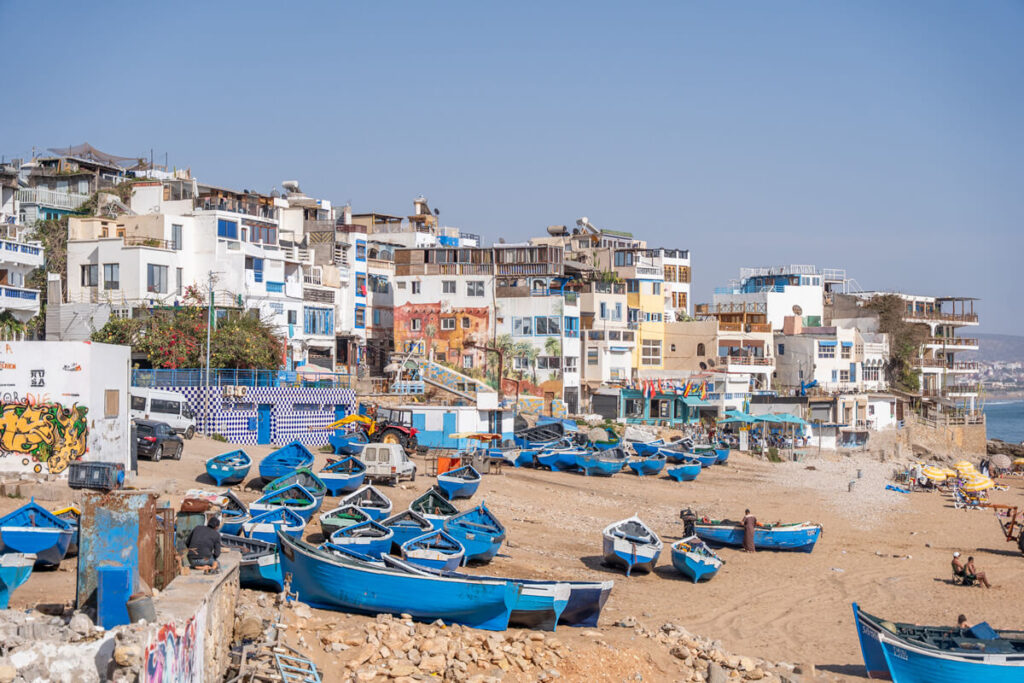

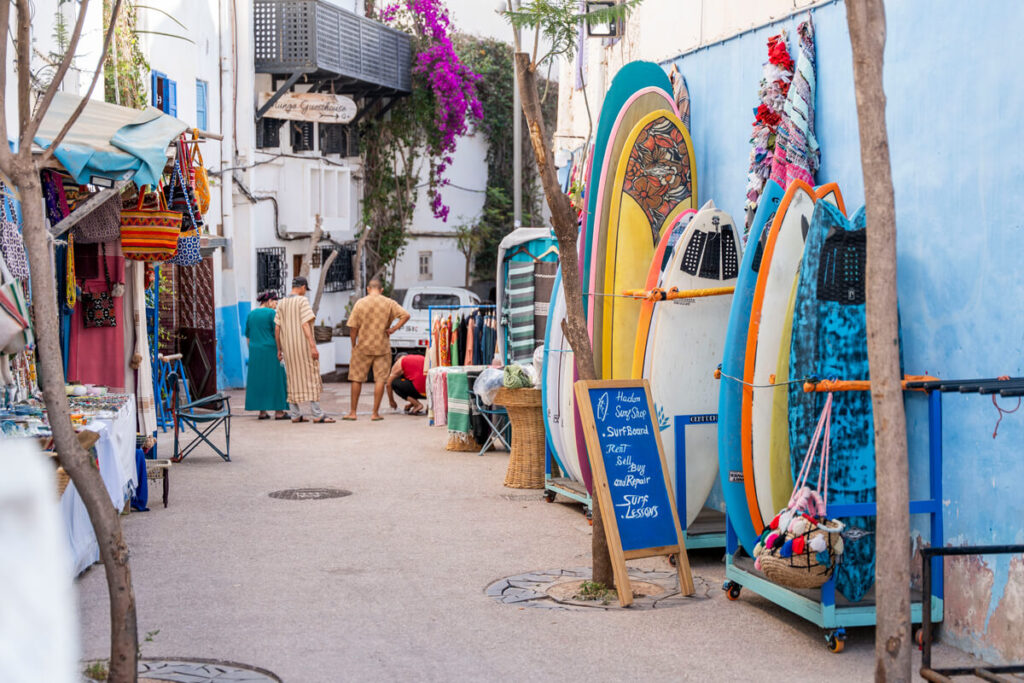
Day 9: The Port City of Essaouira
Today we continue to Essaouira, about 2.5–3 hours north. The old town, with its white walls, fishing port, and blue doors, has its own unique vibe. If we had to describe Essaouira in three words: relaxed, windy, authentic.
Just go with the flow, stroll through the alleys of the medina, eat fresh fish at the harbor, and browse the small shops full of colorful ceramics, argan oil, and handmade souvenirs.
Essaouira always feels completely different from Marrakech—significantly quieter and somehow much more serene. And that’s exactly why it’s the perfect conclusion to your Morocco tour.
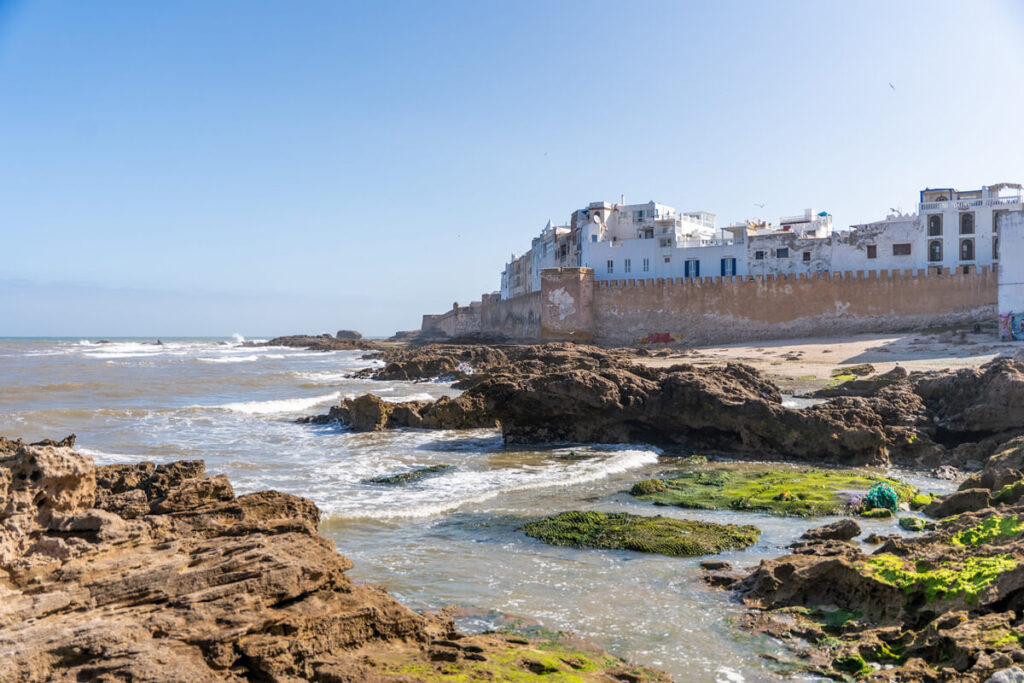
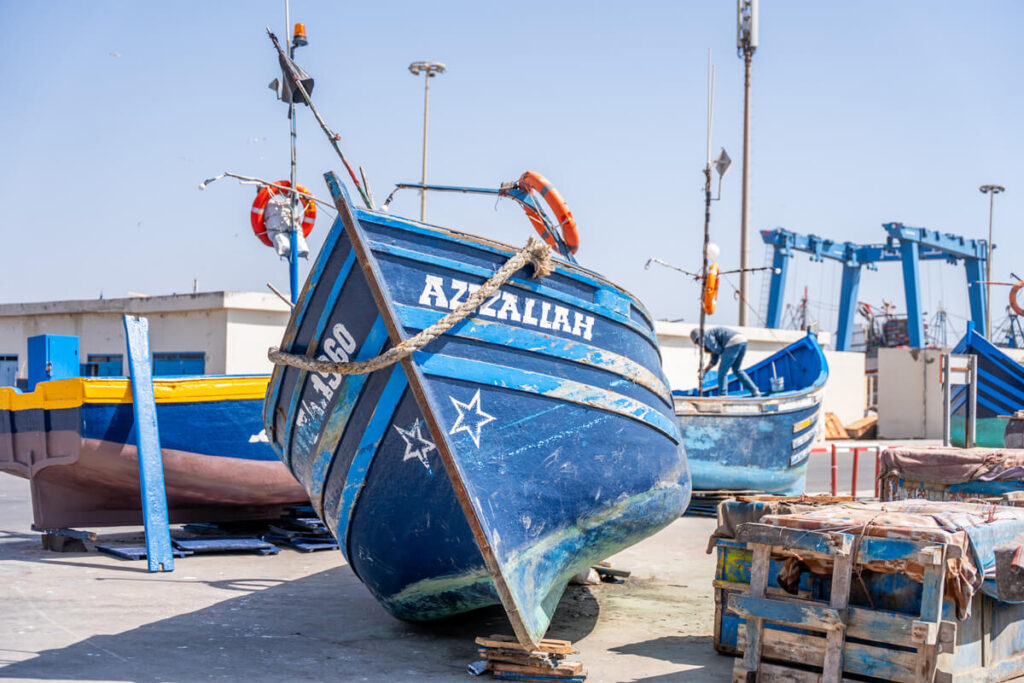
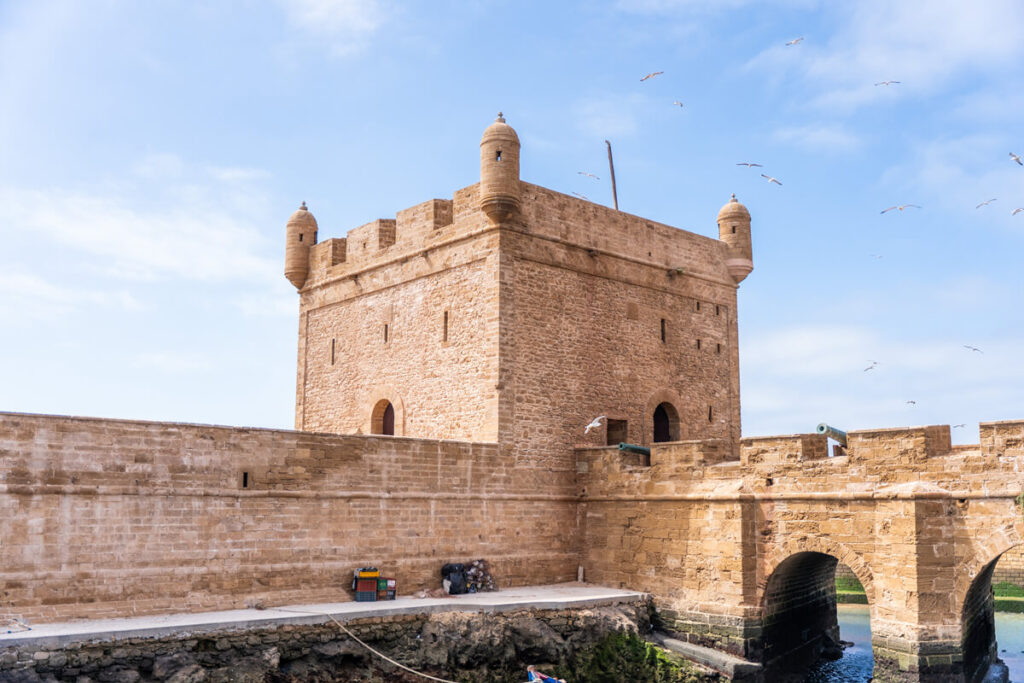
Day 10: Return to Marrakech & Departure
Today it’s time to say goodbye. From Essaouira to Marrakech, it’s about a two and a half hour drive. Depending on your departure time, an early start is worthwhile. If you still have a few hours in Marrakech, treat yourself to a last good meal or a quick hammam session*.
You’ll return with full memory cards, sandy shoes, and quite a few impressions in your luggage. Morocco will probably surprise you just as much as it did us. The country is diverse, intense, and yet somehow less complicated than you might think.
General Morocco travel tips
Arrival: Which airports are suitable?
For a tour of Morocco, Marrakech is an ideal starting point. The airport is well connected, and you can get to the city quickly. If you want to spend a few days by the sea at the end, you can also fly back via Agadir or end your trip in Essaouira and drive from there back to Marrakech.
Tip: Open-jaw flights, such as a one-way flight to Marrakech and a return flight from Agadir, can be practical if you don’t want to drive the entire way back. It’s best to check Skyscanner* or Google Flights to see which combination makes the most sense for your route.
Entry: Visa, passport & Import Regulations
German citizens do not need a visa if they are staying in the country for less than 90 days. A passport that is valid for at least 6 months upon entry is important. A temporary passport is also acceptable. For stays longer than 90 days, you will need a visa.
What you are not allowed to bring: Drones are officially banned in Morocco and are often confiscated at the airport. You should also avoid bringing large quantities of alcohol. However, a bottle of wine or spirits for your own use is okay.
Is it worth renting a car in Morocco?
If you want to explore the country on your own, then clearly: Yes, a rental car is absolutely worth it. The roads are mostly well-developed, the signage is clear, and the landscape is often the first highlight along the way. In our opinion, a rental car is ideal for routes through the Atlas Mountains, the desert, or along the coast. Book your rental car here*.
A few things you should know:
- An international driver’s license is recommended, although it is not always required.
- Be careful of minor damage upon delivery and document everything (photos & videos)!
- Gas stations are regularly located throughout the country (often cash only).
- Observe the speed limits (there are many police and speed cameras).
- Don’t be intimidated by the chaotic traffic in the cities and stay cool!
- Parking fees: 20-30 dirhams per night are fine!
- Use the toll roads to save time.
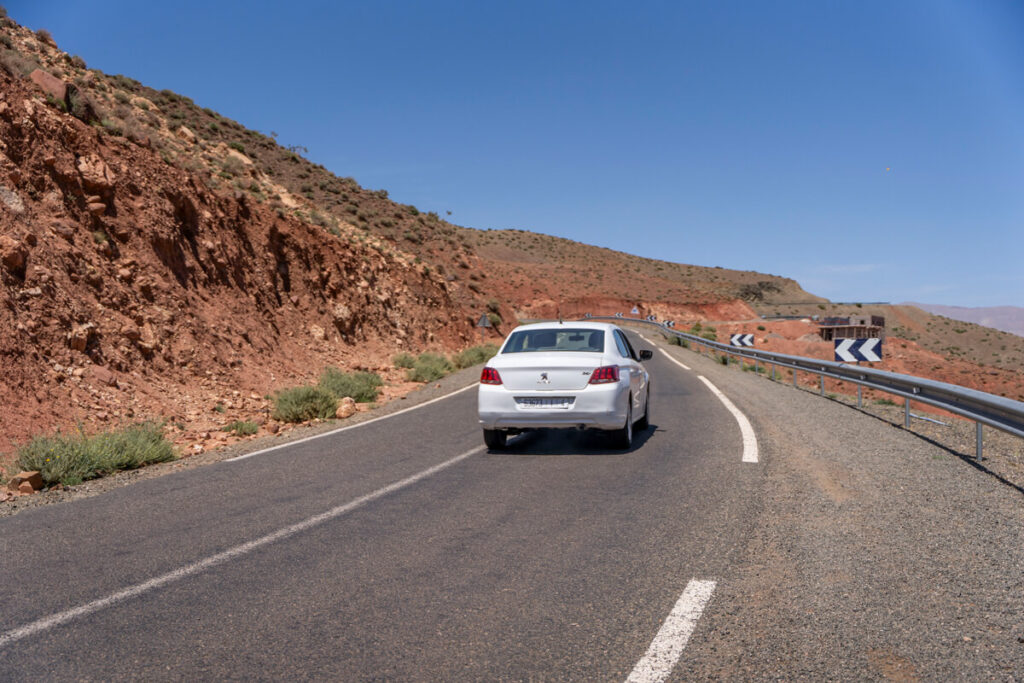
When is the best time for a Morocco tour?
You can travel to Morocco all year round, but it is most pleasant in spring (March to May) and autumn (October to November). Then it is neither too hot nor too cold, and temperatures are bearable even in the Atlas Mountains and the desert.
Summer (July and August) is only recommended to a limited extent, as temperatures in the desert can reach over 45 degrees Celsius. However, it is quite pleasant on the coast. Winter (December to February) is okay for cities and the coast, but it can get chilly in the mountains, and some passes are even snow-covered.
Safety: How safe is Morocco?
Overall, we felt very safe throughout the country. The people are friendly, helpful, and used to tourism. Nevertheless, as always, common sense helps.
What we want to share with you: In cities like Fez or Marrakech, the small alleys can sometimes feel uncomfortable in the evening, especially when there’s not much going on. It helps to get your bearings beforehand and not explore the routes until dark.
‼️And very important: Don’t believe everyone who tells you you’re on the wrong path or that a tourist attraction is closed. This is often just a trick to lure you into a shop or on a “tour.” Simply thank them politely and move on.
How much does a Morocco tour cost?
That depends on many factors, such as the length of the trip, the month of travel, the route, travel style, and so on. We spent around €4,400 (€2,200 per person) on our almost 3-week tour of Morocco.
- Budget: approx. €50–80 per day (simple riads, street food)
- Mid-range: approx. €100–150 per day (beautiful riads, rental car, excursions)
- Luxury: from €250 per day (private driver, upscale accommodations, exclusive activities)

Internet in Morocco
If you want to stay online in Morocco, you have several good options. For example, the eSIM from Airalo* (with the Orange network) is practical. This gives you internet access right upon arrival, without having to worry about anything on site. The connection is generally quite good, although it can be a bit slower in some cities.
Alternatively, you can also get a local SIM card. Providers such as Maroc Telecom, Orange, or Inwi have shops at airports and in almost every city. Activation is usually straightforward, and the packages are usually somewhat cheaper. You can find Wi-Fi in almost all accommodations, restaurants, and cafés.
Morocco Packing List: What Should You Absolutely Bring?
For a trip through Morocco, light luggage is usually sufficient. Summer clothing such as shorts, skirts, linen trousers, T-shirts, blouses, and tops is just right, depending on the time of year. You should also pack a pair of socks and a sweater for cooler evenings.
A light jacket can definitely be useful, especially in the mountains or if you’re traveling in spring or fall. In Essaouira, for example, it was quite windy and surprisingly cool. We were really glad to have a jacket with us.
Comfortable shoes for the cities and excursions are especially important. A hat for sun protection should also be packed. And of course, swimwear if you want to swim in the pool or the Atlantic. Here are a few more things that we found really useful on our trip:
- Power strip* + USB hub*
- You do NOT need an adapter (sockets like in Germany)
- Camera, memory cards & Hard drive for data backup
- Travel pillow* (very important!)
- Sunscreen (better to bring from home – it’s cheaper!)
- Power bank* (long car journeys & desert!)
- Offline maps on your phone (e.g., maps.me or Google Maps offline)
- E-SIM* or local SIM card (e.g., Maroc Telecom)
- Sunglasses & sun hat
- Small jute bag for shopping
- Water bottle* (refillable, saves plastic)